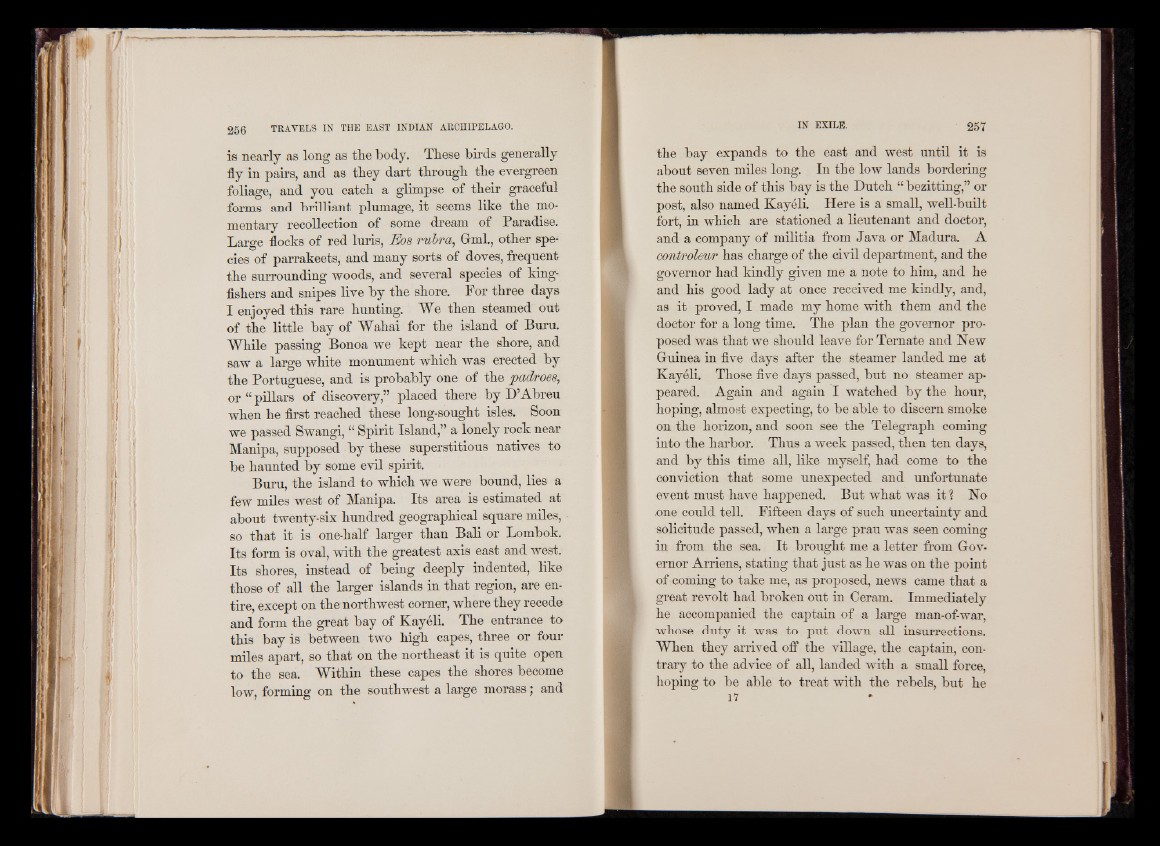
is nearly as long as tlie body. These birds generally
fly in pairs, and as they dart through the evergreen
foliage, and you catch a glimpse of their graceful
forms and brilliant plumage, it seems like the momentary
recollection of some dream of Paradise.
Large flocks of red luris, Eos rubra, Gml., other species
of parrakeets, and many sorts of doves, frequent
the surrounding woods, and several species of kingfishers
and snipes live by the shore. For three days
I enjoyed this rare hunting. We then steamed out
of the little bay of Wahai for the island of Buru.
While passing Bonoa we kept near the shore, and
saw a large white monument which was erected by
the Portuguese, and is probably one of the padroes,
or “ pillars of discovery,” placed there by D’Abreu
when he first reached these long-sought isles. Soon
we passed Swangi, “ Spirit Island,” a lonely rock near
Manipa, supposed by these superstitious natives to
be haunted by some evil spirit.
Buru, the island to which we were bound, lies a
few miles west of Manipa. Its area is estimated at
about twenty-six hundred geographical square miles,
so that it is one-half larger than Bali or Lombok.
Its form is oval, with the greatest axis east and west.
Its shores, instead of being deeply indented, like
those of all the larger islands in that region, are entire,
except on the northwest comer, where they recede
and form the great bay of Kayeli. The entrance to
this bay is between two high capes, three or four
miles apart, so that on the northeast it is quite open
to the sea. Within these capes the shores become
low, forming on the southwest a large morass 5 and
the bay expands to the east and west until it is
about seven miles long. In the low lands bordering
the south side of this bay is the Dutch “ bezitting,” or
post, also named Kayeli. Here is a small, well-built
fort, in which are stationed a lieutenant and doctor,
and a company of militia from Java or Madura. A
controlmr has charge of the civil department, and the
governor had kindly given me a note to him, and he
and his good lady at once received me kindly, and,
as it proved, I made my home with them and the
doctor for a long time. The plan the governor proposed
was that we should leave for Ternate and New
Guinea in five days after the steamer landed me at
Kayeli. Those five days passed, but no steamer appeared.
Again and again I watched by the hour,
hoping, almost expecting, to be able to discern smoke
on the horizon, and soon see the Telegraph coming
into the harbor. Thus a week passed, then ten days,
and by this time all, like myself, had come to the
conviction that some unexpected and unfortunate
event must have happened. But what was it ? No
.one could tell. Fifteen days of such uncertainty and
solicitude passed, when a large prau was seen coming
in from the sea. It brought O me a letter from Governor
Arriens, stating that just as he was on the point
of coming to take me, as proposed, news came that a
great revolt had broken out in Ceram. Immediately
he accompanied the captain of a large man-of-war,
whose duty it was to put down all insurrections.
When they arrived off the village, the captain, contrary
to the advice of all, landed with a small force,
hoping to be able to treat with the rebels, but he
17